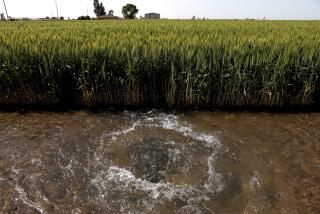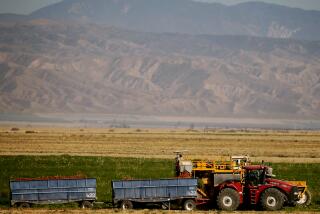Feud between 2 obscure water agencies costs consumers
Bell resident Robert Mackin is frustrated that his monthly water rate keeps rising, by about 50% in the last few years.
He writes the check to his water provider, Golden State Water Co. But he is actually served by six separate agencies that each play a role in delivering his water — and charging him for the service.
“I’ll be honest, I don’t really have an idea of what all these agencies do … it’s hard to understand,” Mackin said. “When the bill comes in, I look at the total and write the check.”
And he’s not alone.
Two of those water districts — which serve more than a third of the nearly 10 million residents of L.A. County — have more than doubled their fees in recent years while spending significant amounts of time and money battling each other in a series of lawsuits, legislative showdowns and unusual PR campaigns.
The water war between the Central Basin Municipal Water District and Water Replenishment District of Southern California has been largely unknown to the public because neither agency delivers water directly to customers, and their charges are rolled into the bills sent out by retailers. But local officials say it has become an increasingly costly fiasco.
“It’s just a huge embarrassment for the region,” said Ken Farfsing, city manager of Signal Hill. “It’s almost like they’ve forgotten what they’re fighting about and want to win regardless of the costs.”
The conflict offers a window into the highly decentralized world of water operations in Southern California. Across the region, hundreds of different public agencies are involved in the purchase, sale, distribution and delivery of water to residents. Many of them overlap in their service areas and functions, and most operate under little public scrutiny.
The size and complexity of the network can make it difficult to match increases in residents’ water bills to specific expenses incurred by the districts.
The increases in Mackin’s bill are due in part to rising charges by his water provider, Golden State. But it also includes fees from Central Basin, the WRD, the state Department of Water Resources, which manages the state water project, the Metropolitan Water District, which imports water to Southern California, and L.A. County, which plays a role in local groundwater replenishment.
Critics argue that the huge bureaucracy leads to duplicated programs and wasteful spending, especially when individual agencies clash over new projects and legal issues.
In local water circles, the Central Basin-WRD feud has become a prime example of that problem.
After Central Basin sponsored a bill in the state Legislature that would give it new authority over its rival, the Water Replenishment District supported legislation that would strip Central Basin of some of its powers.
Central Basin hired an outside consultant to produce positive articles about its projects and post them on Google News, including several that took issue with policies of the Water Replenishment District. The WRD bought up domain names such as “centralbasin.net,” which it used to publicize critical news stories and letters about Central Basin.
Last year alone, the two agencies were adversaries in five separate court cases, battling everything from authority over groundwater to charges of cybersquatting and trademark infringement.
Amid all the fighting, the districts have failed to accomplish what officials at both agencies say is a crucial mission: increasing the amount of local groundwater storage. Such a move could result in lower rates for customers in L.A. County as well as significant water conservation savings.
Even though they strongly defend their positions, the heads of both agencies acknowledge that the legal and policy disputes have proved costly.
“If I were to talk to somebody on the street about it, I would say ‘Sorry… Sorry that we’re spending your money on litigation, but we have to fight for your interests,’ ” Central Basin General Manager Art Aguilar said.
Robb Whitaker, the head of the Water Replenishment District, called the situation “tragic.”
“This whole thing is costing the public money and precious time,” he said
::
Because water is such a precious commodity in Southern California, a massive network of agencies has formed to help maintain the region’s supply. While voters elect some of the agencies’ governing boards, many residents have little idea what they do.
The bureaucracy has grown over the last century as the region struggled with water shortages. Many districts formed after World War II, when the surging population and excessive pumping led to a rapid drop in local groundwater levels. Others were created to help import needed water from outside the state.
For decades, Central Basin and the WRD operated out of the same office in Downey. They shared the same general manager and a staff that totaled about six.
But the two agencies split in 1992 after a disagreement between their respective boards.
The districts’ operations have since swelled — and so have their budgets. They now occupy separate headquarters and together employ more than 50 people.
The changes have been driven in part by new leadership. Originally overseen primarily by water experts and engineers, Central Basin and the WRD have become popular destinations for people with political backgrounds. Of the 10 current board members at the two districts, eight have held other public offices or worked as political aides or consultants.
At their core, both districts perform very specific, complementary functions. Central Basin acts as a middle man, purchasing imported water from the behemoth Metropolitan Water District and wholesaling it to municipal water departments and private retailers. Its service area includes 24 cities in southeast L.A. County and more than 2 million residents.
The Water Replenishment District serves the same area, along with the adjacent western water basin and several additional cities. The agency’s main job is to collect funds from pumpers in the region, which are then used to purchase water for replenishment purposes.
Over the last two decades, though, the districts have become increasingly involved in other areas of the water business, such as reclamation, treatment and conservation. At times, they have also faced questions over their spending decisions and rate increases.
The WRD was slammed in a 1999 state audit, which found it had managed its infrastructure projects poorly and amassed an excessive reserve fund by overcharging ratepayers. Two years later, a separate state report took Central Basin to task for the planning of its recycled water distribution system.
Central Basin was criticized in 2001 after it reimbursed a board member for acting classes, flying lessons and seminars with the motivational speaker Anthony Robbins.
Both districts’ rising rates have also raised eyebrows.
The WRD’s replenishment assessment, which it charges groundwater pumpers, has increased from $115 per acre-foot in 2004 to $244 this year.
During the same period, Central Basin’s surcharges have grown from $37 per acre-foot to $90 this year, bringing the total cost of its wholesale water over $900 per acre-foot. The district recently announced it was freezing rates and “challenged” the WRD to do the same. But the increases — combined with hikes made by other water agencies like the MWD and Golden State — have generated anger among residents and prompted another state audit.
“There are people here who now have a decision,” said Alfred Areyan, a longtime resident of Bell. “They can pay the water bill, or they can pay for food that month.”
::
The costliest and most protracted battle of the water war involves the seemingly wonkish issue of groundwater storage.
About a decade ago, new surveying technology revealed additional space available for groundwater storage. The space is an extremely valuable resource because it could allow purveyors to store huge amounts of extra water in wet years and save it for dry ones, when imported water prices surge.
But efforts to use the space have prompted a long-running legal fight.
An initial plan submitted by a group of cities and water companies was blocked by the WRD in 2003. Then, after years of mediation, a new system was proposed. That motion was challenged by Central Basin in 2009, which said it gave too much power to the WRD. Last year, Central Basin announced it was developing a plan of its own.
The districts also have been at odds over the assessment charged by the WRD. Central Basin and a group of cities allege that the fee is unjust and that it disproportionately affects residents in southeast L.A. County, to the benefit of customers in the western half of the WRD’s service area. Several lawsuits have been filed over the issue in the last two years.
Since the start of 2008, WRD officials said they have paid about $2.3 million to attorneys litigating five different cases involving Central Basin. Officials at Central Basin said they were not sure exactly how much they have spent on those same cases. However, invoices obtained by The Times under the California Public Records Act show more than $1.8 million in legal billings during the same period with matters pertaining to the WRD.
Leaders of both agencies say the costs are necessary. Aguilar, the Central Basin general manager, said his agency was fighting “water policy for the wealthy,” favored by the WRD and others.
“I don’t think that constitutes a feud,” he said. “I think we’re just doing our job.”
Whitaker, however, characterized Central Basin as an aggressor, saying that his district has no choice but to defend itself against “an agency that has stepped into our backyard and tried to take over what we do.”
But officials at many cities and water companies served by the districts say the battle has gone too far.
“We’re at the point where it’s so polarized it’s hard to get anything done,” said Kevin Wattier, general manager of the Long Beach Water Department. “It completely gets in the way of good water management.”
More to Read
Sign up for Essential California
The most important California stories and recommendations in your inbox every morning.
You may occasionally receive promotional content from the Los Angeles Times.










